Some people asked me if it would be worthwhile travelling to Ladakh after the terrible cloudburst at Leh and deluge in rest of Ladakh that killed more than a hundred people. Until recently, I wasn’t very sure about the right answer to the question. While I knew that weather had improved and would not be a threat to travellers, I was trying to find answers to a few other questions that bothered me. Was Leh resourceful enough to handle tourists? Would tourists be benefiting the local economy that has now suffered a sudden loss of business or would they become a burden to a recovering Leh? Are there sufficient resource available for locals (food, water, transport, etc,..) so that tourists will not become a burden to the local population with more mouths to feed?
I spoke someone I know in Leh who responded positively to my doubts. He was a travel agent whose house was located in Choglamsar – the place that suffered maximum damages from the cloudburst. Half of his house, his garden and surroundings were washed away in the mudslide, but thankfully his family survived. Though he welcomed tourists and said that it will be good to have visitors, I still wanted to hear from someone outside the travel industry, just to be sure. A few recent threads on indiamike have finally provided an answer. With that, here is some useful information to anyone who wants to visit Ladakh now.
How is the weather in Ladakh now? Is it safe after the cloudburst?
The weather in Leh and most of Ladakh has stabilized. It is no longer raining like the day of the disaster and it should be reasonably safe to travel in Ladakh. My agent in Leh says some peaks are seeing occasional deposits of snow in the last two weeks, which means that chances of rain have reduced and precipitation, if at all, could be in the form of snow and will not be dangerous.
But on any given day in Ladakh, you can always run into a weather that blocks the high passes and gets you stranded for some time. This doesn’t relate to cloudburst or the excess rain that Ladakh saw this year; this could happen to anyone travelling to Ladakh any time and people have gone through some difficulties even in the earlier years, even during summers. Overall, it is safe to travel.
Are all the important places to visit accessible now? Are the roads and the passes in Ladakh open?
My travel agent in Leh says most of the well known places are now accessible. You can visit Nubra Valley, Pangong Tso, Tso Moriri and Tso Kar Lakes, Lamayuru and the monasteries of Indus Valley (Hemis, Thiksey, Spithuk, Alchi, Likir, etc). Buses are plying between Srinagar and Leh, but not everyday as it depends on occupancy. Flying to Leh should not be a problem. Manali-Leh road has remained closed, since the stretch from Tanglang la to Upshi is damaged very badly and may take a long time to repair. According to an indiamike thread (see below), jeeps (not buses) are plying on the longer route via Tso Kar and Mahe Bridge.
According to this information, not every trek route is open as some bridges have washed away in places that are yet to be restored. If you are planning a trek, ask you agent very clearly if the entire route is open and safe.
Are tourist facilities in Leh open? What about basic amenities like power supply, water, etc?
As mentioned in discussion threads on indiamike, while some hotels and restaurants have shut for the season due to poor business, there are hotels and restaurants in Leh that are open to cater to you. Power supply is limited and is restricted to a few hours in the evening, since Leh is now running only on diesel generators and hydroelectric power generation has not yet resumed. Water supply too is intermittent but there seems to be no major crisis of water. Some excerpts by on recent threads on indiamike.
Indiamike user sbballer33 says on this thread
Buses are running to Srinagar (800 INR) though not every day and it depends on demand. Manali only jeeps and private minibusses are going via Tso Kar charging between 2000 and 3000 per person…
and according to user papillon in this thread
As a tourist you have to put up with a lot of dust, a not too regular water supply and power cuts. Means that if you don’t need a hot shower twice a day, wou will get along easily. Internet connection is slow, but there are three working ATMs… I haven’t heard one word about general food or water shortages.
How long are the roads open before the winter begins? Till when is it possible to travel to Ladakh?
Manali-Leh road is unlikely to reopen this year due to big landslides between Tanglang la and Upshi. The alternate route through Mahe bridge and Srinagar-Leh road may start seeing occasional closures due to snow fall after September and may close for the winter any time in October/November. Exact dates depend on the weather. But most passes within Ladakh (Khardung La, Chang la) will be kept open by the Indian Army through the winter, though they may close temporarily due to snow fall. If you fly into Leh, it should be possible to visit Nubra Valley, Pangong Tso and monasteries of Indus Valley through the year. Keep in mind that winter temperatures fall below -20C in peak winters.
Young monks and children were to be seen everywhere at the Korzok Gustor Festival. Some images of kids and kid-monks watching the performances or taking part in the activities.
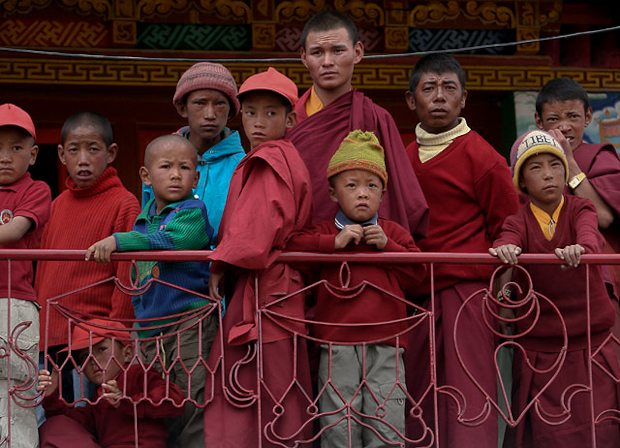
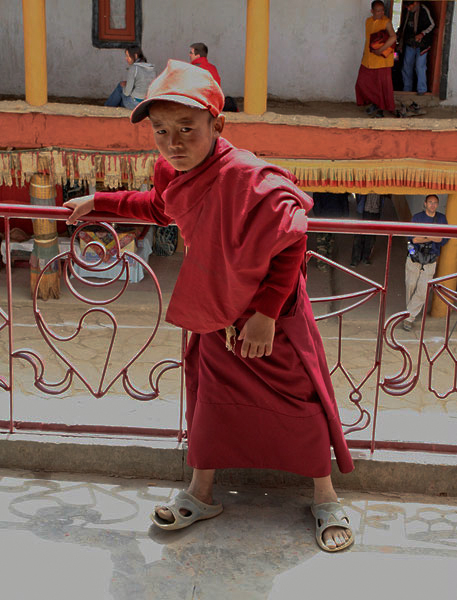
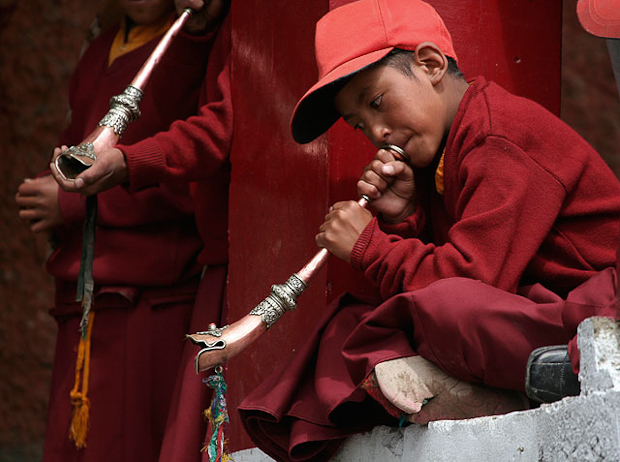
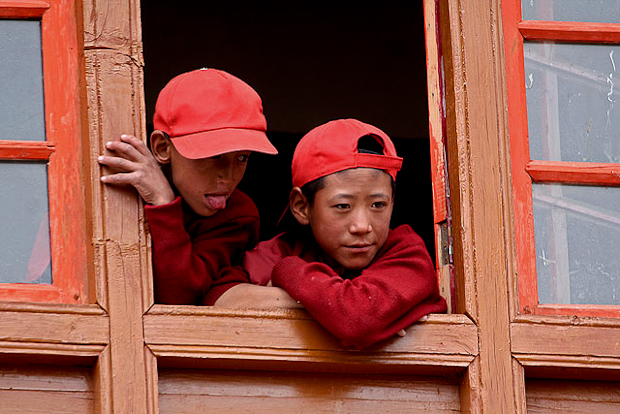
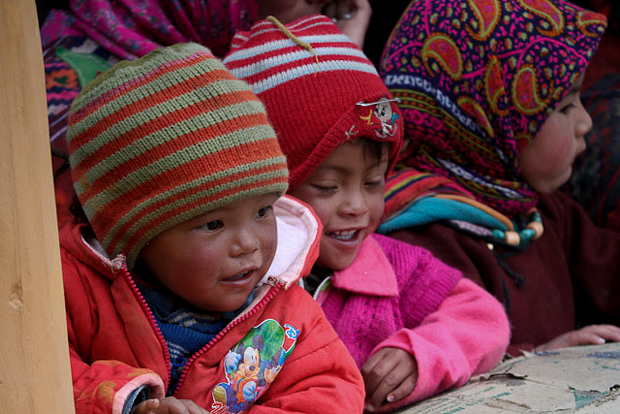
Prints of all the images available. Request for prints.
On the morning of July 4th, there was a visible excitement outside Korzok Monastery. People moved back forth in anticipation of an exciting day. The place was full of people who had come from pastures located near the village. Women moved around in excitement, wearing best of their traditional attire and jewelry and excitedly talking to old friends whom they were meeting after a long time. The lamas walked back and forth or worked on the last touches for the festival day. Some were getting the costumes out, some were preparing the masks and a few were taking out the musical instruments. It promised to be an exciting day.
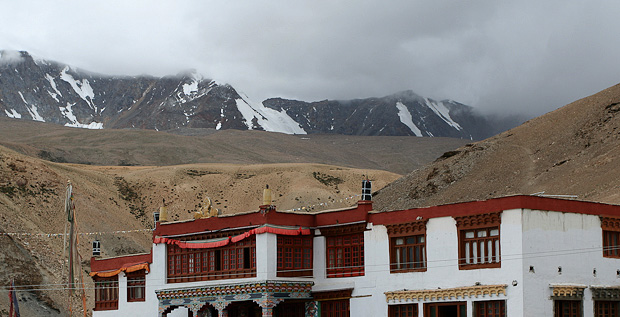
Korzok Monastery and the mountain slopes of changthang
It was the day of Korzok Gustor Festival at the most popular monastery in Changthang region. The monastery’s affiliation was not limited to Korzok Village alone but extended to many changspa nomadic groups who wandered the plateau looking for grasslands to feed their animals. It was a day when most of these nomads would come together to witness the celebrations.
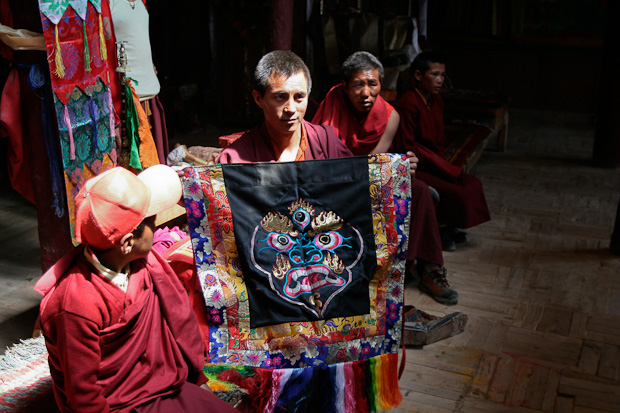
Getting ready..
The festival perhaps begins early in the morning as lamas perform long rituals in the prayer hall. I had been hoping to catch these rituals but despite asking many people including a few lamas, it seemed impossible to get the schedule of activities during the two-day festival. I would get a different answer each time I asked someone, and worse, I would get different answers when we asked the same person second time. What was left for us was to hang out at the monastery the whole day and hope not to miss anything.
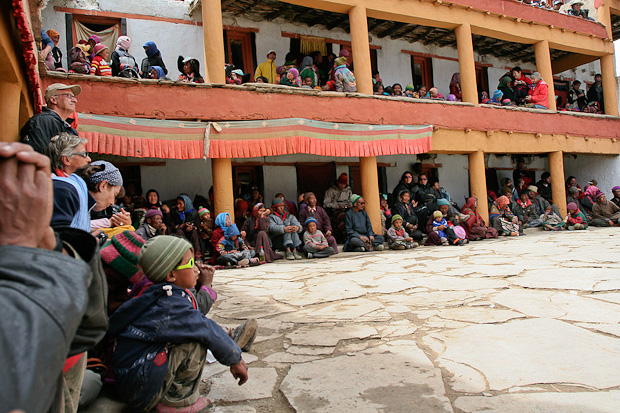
watching the performance
We did miss the prayers but not the cham-dances, the most attended and perhaps the most important part of the two day festival. The whole village and the nomad population squeezes itself to the tennis-court sized courtyard to watch the lamas dance. In the past decade or so, addition of an equal number of tourists coming in to witness the show meant you had to arrive really early to look for a good place to watch the happenings without any obstructions.
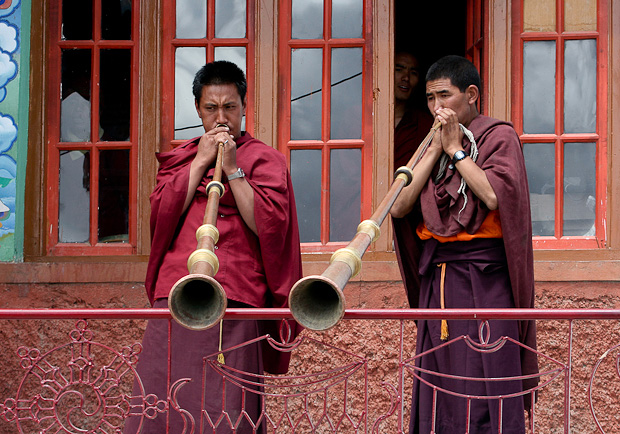
Dung chen, the long trumpets
The festival began with a sudden eruption of sound from dung-chens (very long trumpets) as the head lama walked into the courtyard and conducted a short ritual. Lamas came out one after the other and performed the slow cham-dances synchronized to the sound of drilbu (bells) and nga (drums).
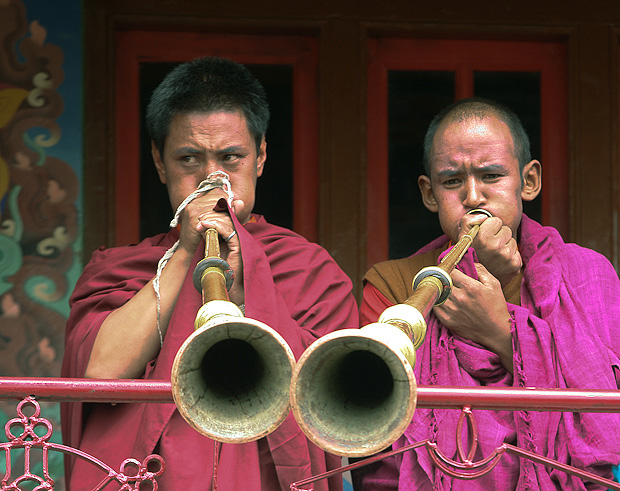
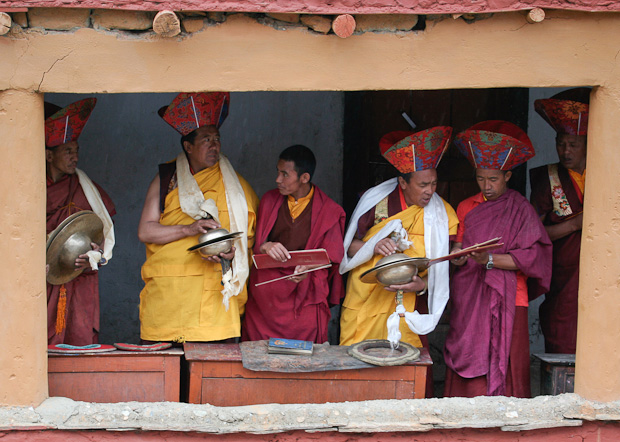
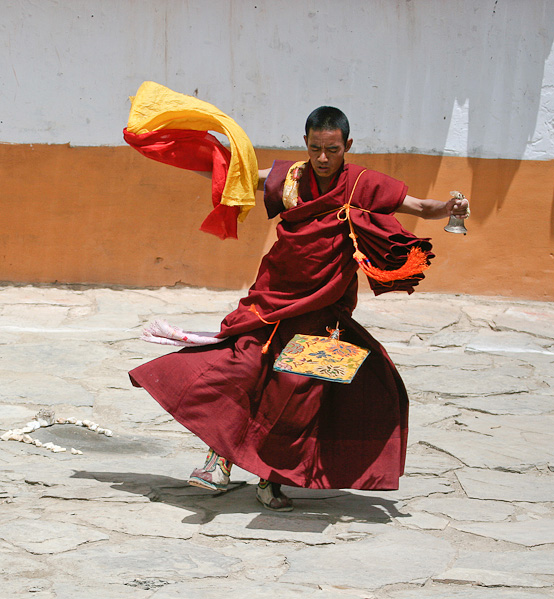
cham dance performance
On the second day, the celebration began by bringing in a few animals to the monastery. The pack included two horses and several goats, later joined by a well fed yak that instantly gained my respect, thanks to its size. It was time to worship these animals that had worked hard through the year to help the Ladahis make their living. The animals were cheered by changspa men as well as the lamas. Lamas applied butter on their forehead and threw a maroon paste on their body. This is a land where perhaps everything is sacred, not just animals but even beer. So it was time to shake a beer bottle and sprinkle on the animals. Shaken by the cold and scared by the noise, the horses got jumpy and the goats were shivering. The horses tried to run and then started fighting between each other, but the lamas quickly herded them out of the monastery and ended their agony. However, no one tried to mess up with the lone giant yak later; it had a size the automatically gets everyone’s obeisance.
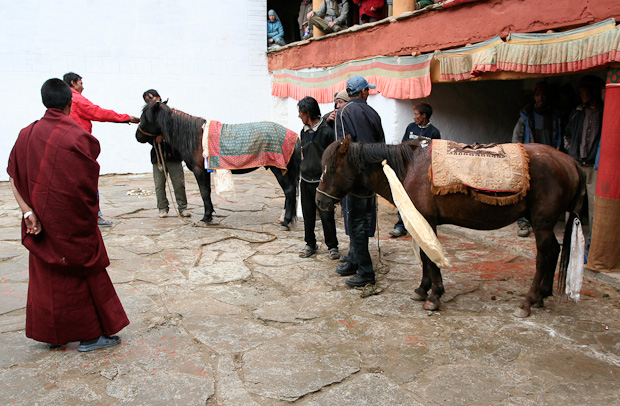
It was time for the cham-dances. The monks danced without the masks on the first day and repeated the performance wearing masks on day two. The masks came in various shapes – of demons, of strange creatures like cows with canines and of forms that can beat anyone’s imagination. The dances began slow and easy as the monks took deliberate steps circling around the flagpole at the center of the courtyard. The pace improved slowly with the progress in the dance and concluded with sudden and swift moves that were more suitable to the wild demon-like cover on their faces.
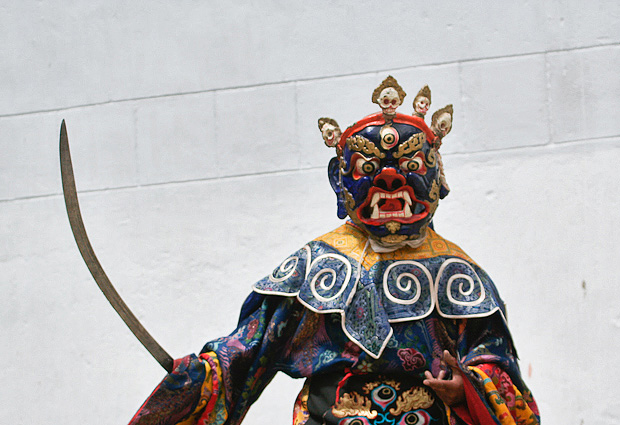

cham dance performance
While all this serious work with calculated beats and synchronized steps went on at the center of the courtyard, there was a masked man walking around with a whip scaring children and anyone who was likely to get scared. Some people laughed at him and pushed him away while he managed to push a few himself. He went to a corner full or tourists, showed the whip, shook his head and demanded them to part with money. A few obliged with small bills and others let out a nervous laughter. He tried the same with a Ladakhi girl later and got beaten up by her in response. These people of Ladakh never take anything seriously, not even the religious rituals. At the same time, Ladakhis are deeply religious and Buddhism defines a great deal of their everyday life.
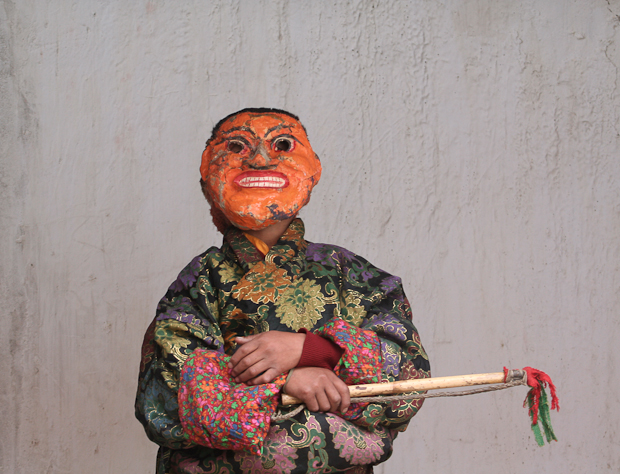
That evening, we were walking on the lake shore enjoying the quiet, cloudy evening, watching small waves hit the grassy shoreline. Tso Moriri’s shore is among the most beautiful places I have seen in Ladakh. To one side of me was a vast blue lake flanked by tall peaks with just a little bit of snow dotting their tips. On this side of the lake was a green stretch of grassland, a spectacle rarely seen in the barren landscape of Ladakh. The scale and grandeur of the lake and mountains seemed to have an ability calm the mind and instill peace, letting the million things that haunt in the head disappear for a moment.
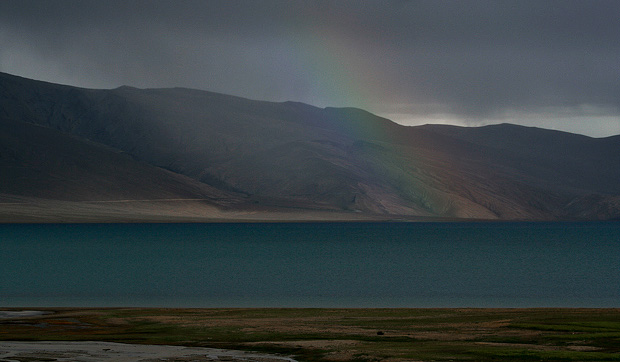
Tso Moriri Lake
As we walked slowly along the shore letting the cool breeze of the cloudy day caress us, I heard some voices coming from the village. A small procession had begun from the monastery, with a lama holding a fire leading the way and the entire village walking behind him. We joined them quickly as they gathered just outside the village. A mask—the kind that is used during the cham dances—was put on fire as the villagers stood in a circle and watched the smoke go up. It marked the end of the festival, symbolizing burning of all evil that had accumulated in the past one year.
Prints of all the images available. Request for prints.
















